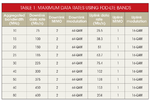criterion456
Member level 2
Hi,
For the description:
Due to the differences between
FDD and TDD, the same amount of aggregated bandwidth results in different downlink and uplink data rates.
Therefore, 40-MHz aggregated bandwidth in FDD-LTE results in a maximum downlink data rate of 300 Mb/s,
while 40 MHz aggregated in TDD-LTE results in a maximum rate of 224 Mb/s


As shown above, obviously,
the data rates of FDD(Frequency Division Duplexing) is higher than which of TDD.
Nevertheless, according to Shannon Theorem

I don’t know what makes the difference.
What keys words should I google ?
Thanks~!
For the description:
Due to the differences between
FDD and TDD, the same amount of aggregated bandwidth results in different downlink and uplink data rates.
Therefore, 40-MHz aggregated bandwidth in FDD-LTE results in a maximum downlink data rate of 300 Mb/s,
while 40 MHz aggregated in TDD-LTE results in a maximum rate of 224 Mb/s


As shown above, obviously,
the data rates of FDD(Frequency Division Duplexing) is higher than which of TDD.
Nevertheless, according to Shannon Theorem
I don’t know what makes the difference.
What keys words should I google ?
Thanks~!